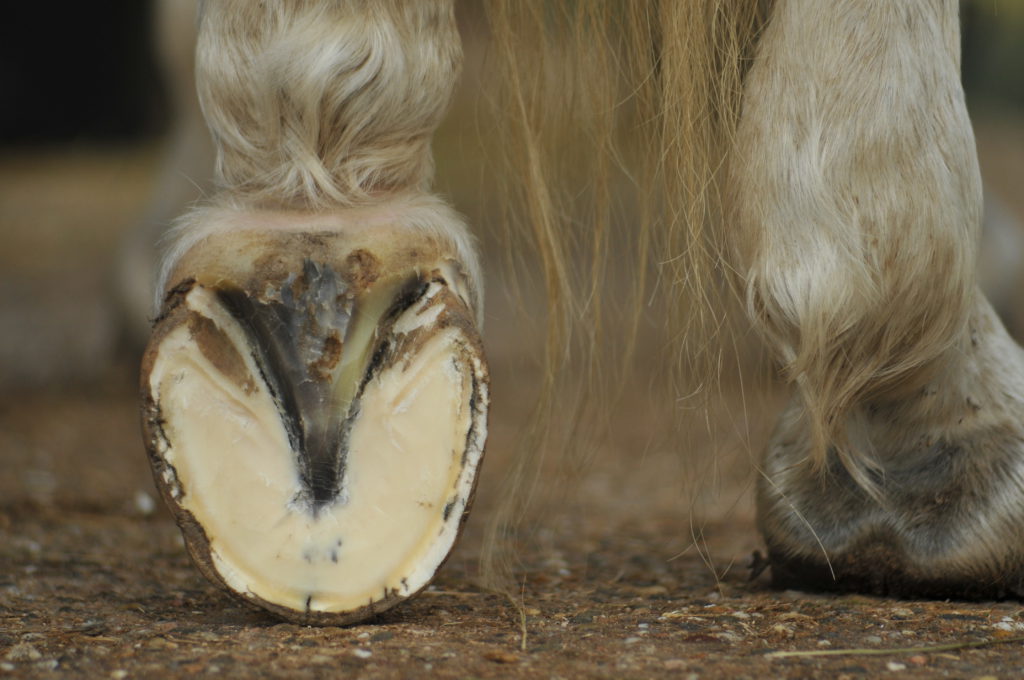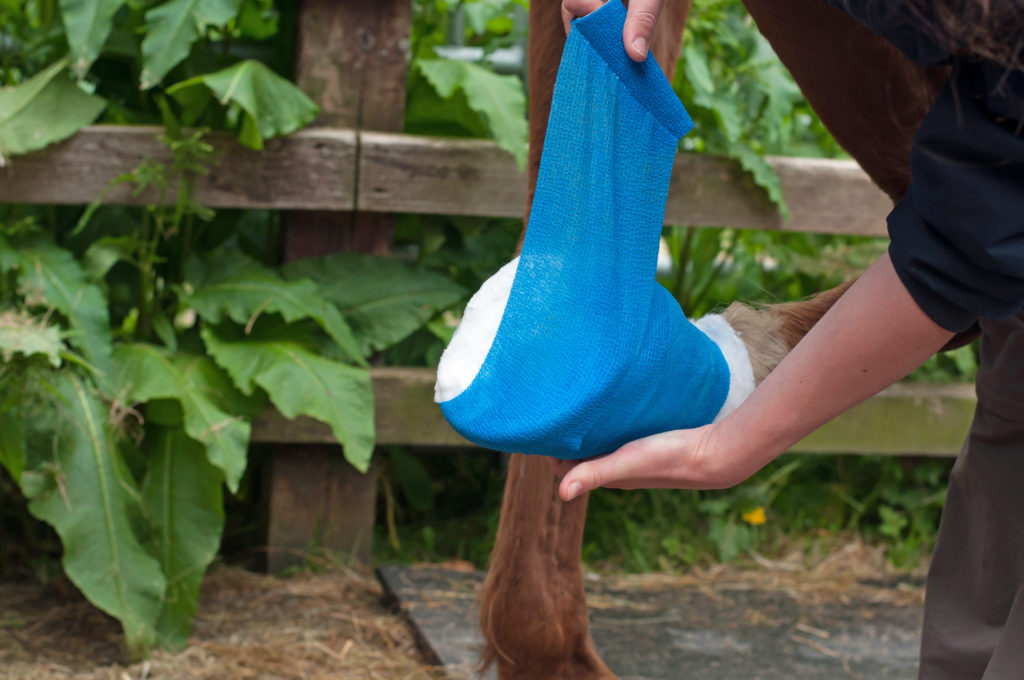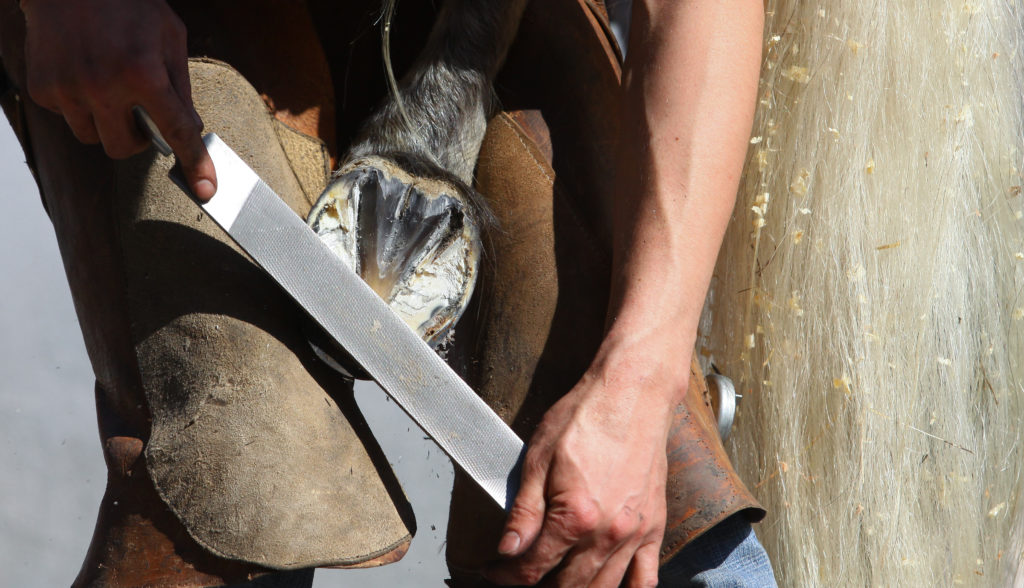Hoof Abscess

What is a hoof abscess?
A hoof abscess is an accumulation of pus under the horn of a horse’s hoof sole or hoof wall. It is in between the regenerative tissues that produce the hoof’s horn and the horn itself. The pus is trapped in a confined space and compresses the sensitive tissues of the foot, so a hoof abscess is very painful to the horse and results in significant, noticeable lameness.
How do hoof abscesses occur?
A hoof abscess cannot occur without bacteria passing through the horn of the hoof and gaining access to the tissue inside the hoof capsule. There are several ways in which bacteria can gain entry to the inside of the hoof, but by far the most common way that this occurs is when the white line of the hoof is breached be the wall of the hoof pulling away from the sole. This most typically occurs when the hoof is poorly conformed, overdue for trimming, and/or when the hoof was been in wet conditions for a protracted period of time.
What happens to a hoof abscess if there is no intervention?
If left untreated, hoof abscesses will mature and rupture. They can rupture downwards out the sole of the foot, or track up the wall of the hoof and pop out at the coronary band of the hoof. Rupture of a hoof abscess normally results in rapid improvement of the horse’s lameness, but the abscess can re-occur if the rupture channel becomes plugged and pressure is able to build up once more.
On rare occasions, hoof abscesses can track inwards and cause infection of the inner structures of the foot. This poses a significantly bigger risk to the horse’s health and can be difficult to resolve.
Horses that are not vaccinated against tetanus can also get tetanus from untreated hoof abscesses, and the tetanus may develop several days or weeks after the abscess resolved.
Untreated hoof abscesses are a significant source of pain for the horses that suffer them. Significant lameness in any horse warrants investigation, irrespective whether it results from a hoof abscess or some other source. Leaving a significant lameness untreated can post a significant risk to the horse’s health, particularly if the lameness results from something other than a hoof abscess.
Are some horses predisposed to hoof abscesses?
Yes.
Any condition that results in weakness of the white line will facilitate the entry of bacteria into the foot. Examples of this include poorly conformed feet, hooves that are overdue for trimming, or hooves with evidence of chronic laminitis.
Furthermore, any condition that reduces the immune system’s ability to fend off infection will also facilitated the development of hoof abscesses. Old age and “Cushing’s disease” (Pars Pituitary Intermedia Disease, AKA PPID) are key examples.
Signs that a horse may have a hoof abscess
A hoof abscess causes a horse to be significantly lame, and often suddenly lame. There is often noticeably increased heat in the affected foot, and digital pulses (felt at the fetlock), may be elevated.
It is important not to make assumptions when examining your horse for lameness. Although hoof abscesses are the most common form of sudden and significant lameness during the wet months of the year, there are several more serious conditions that can present in exactly the same way. Contact a veterinarian if you have any doubts at all.
Treating a hoof abscess
If there is a wet, black spot in the white line of the hoof, then it is likely that bacteria entered the foot from there. Making a small hole at this point can relieve the pressure of the abscess and improve the horse’s comfort. Prevent re-plugging of the hole with poulticing or iodine-soaked cotton wool.
It is important that a person treating an abscess is very specific with regards to where they are making a hole. If you cannot tell where the abscess is in the hoof, do not start making holes.

Poulticing
There are many different products on the market for hoof poulticing. Characteristics of a good product include ease of use and durability in wet conditions, especially if the horse lives in wet paddocks.
Pain relief
Most of the pain from a hoof abscess comes from the pressure on the sensitive tissue of the foot, so relieving that pressure is essential. A component of the pain is due to inflammation, however, so administering bute also greatly improves comfort once the abscess has been opened.

Blacksmith, or equine farrier, fits a horse shoe to a horse’s hoof with a rasp.
Prevention of hoof abscesses
Keeping a horse up-to-date with farrier visits is essential for preventing hoof abscesses.
Grazing horses out of the mud and wet as often as possible is also useful.
Ensuring that your horse grows good hoof by supplementing them with biotin is very useful. Stronger hooves are less likely to crack, split or pull away from the white line, thus preventing bacteria from gaining access to the inside of the hoof.
Correcting hoof conformation issues wherever possible is necessary. For instance, horses/ ponies that have foundered in the past and have rotated pedal bones can be particularly predisposed to hoof abscesses, so addressing this with corrective trimming and shoeing is essential.
Repeated hoof abscesses in the same spot
If your horse repeatedly gets hoof abscesses in the same location, there may be a conformational issue or a foreign body in the hoof that is making this happen. Veterinary attention is advised.
Hoof abscesses in foal
Although foals can get hoof abscesses, they are much less predisposed to it than mature horses. Also, there are several potentially life-threatening conditions that can cause lameness in a foal, so it is best to contact your veterinarian directly if you have a foal that is lame.
Secondary problems associated with hoof abscesses
On rare occasions, hoof abscesses can rupture inwards and cause infection of the deep structures of the foot. Furthermore, any horse that is not fully vaccinated against tetanus should receive a protective tetanus anti-toxin injection when they get a hoof abscess.
Please don’t hesitate to contact Wanganui Veterinary Services if you have any queries regarding lameness in your horse.
References:
Burba, D.J. (2010). Surgical treatment of equine foot disorder. Proceedings of the American Association of Equine Practitioners – Focus on the Foot Meeting, 112-131
Carter, K.C. (2011). Hoof cracks and wall defects. Proceedings of the 56th Annual Convention of the American Association of Equine Practitioners (AAEP), 522-526
Dabareiner, R.M. (2009). Hoof care to enhance hoof quality. Proceedings of the 31st Bain Fallon Memorial Lectures, 138-140
Mansmann, R.A. (2012). Considerations of equine foot infections and treatments. Proceedings of the 17th Congress of the Italian Association of Equine Veterinarians, 86-88
Meagher, D.M. Surgical repair of conditions of the equine foot, including hoof wall defects. Proceedings of the 13th Bain Fallon Memorial Lectures, 39-51
Morrison, S. (2006). Hoof capsule injury and repair. Proceedings of the New Zealand Equine Veterinary Association, 15-18
Rucker, A. (2015). Pathology of the foot: from abscess to injury. Proceedings of the 37th Bain Fallon Lectures, 136-144
Turner, T.A. (2013). Diagnosis and management of septic condition of the foot. American Association of Equine Practitioners Focus on the Foot Proceedings, 33-40
Walmsley, J.P. (1999). Miscellaneous hoof conditions. Proceedings of the 21st Bain Fallon Memorial Lectures, 163-168
Walmsley, J.P. (1999). Reconstructive surgery of the hoof and coronet. Proceedings of the 21st Bain Fallon Memorial Lectures, 156-160


